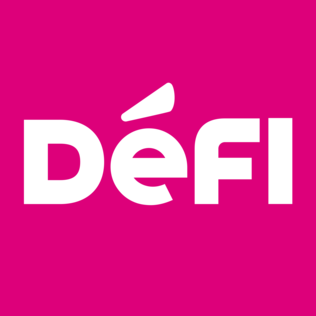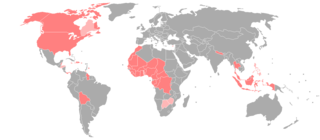Related Research Articles

The Organisation internationale de la Francophonie is an international organization representing countries and regions where French is a lingua franca or customary language, where a significant proportion of the population are francophones, or where there is a notable affiliation with French culture.

Voeren is a Flemish Dutch-speaking municipality with facilities for the French-speaking minority, located in the Belgian province of Limburg. Bordering the Netherlands to the north and the Wallonia region's Liège Province to the south, it is geographically detached from the rest of Flanders, making Voeren an exclave of Flanders. Voeren's name is derived from that of a small right-bank tributary of the Meuse, the Voer, which flows through the municipality.

DéFI is a social-liberal and regionalist political party in Belgium mainly known for defending French-speakers' interests in and near the Brussels region. Founded in 1964, the party is led by François De Smet, a member of the Chamber of Representatives. The party's current name, DéFI or Défi, was adopted in 2016 and is a backronym of Démocrate, Fédéraliste, Indépendant meaning "challenge" in French.

French Sign Language is the sign language of the deaf in France and French-speaking parts of Switzerland. According to Ethnologue, it has 100,000 native signers.
This article presents the current language demographics of the Canadian province of Quebec.

In Belgium, the French Community refers to one of the three constituent constitutional linguistic communities. Since 2011, the French Community has used the name Wallonia-Brussels Federation, which is controversial because its name in the Belgian Constitution has not changed and because it is seen as a political statement. The name "French Community" refers to Francophone Belgians, and not to French people residing in Belgium. As such, the French Community of Belgium is sometimes rendered in English as "the French-speaking Community of Belgium" for clarity, in analogy to the German-speaking Community of Belgium.

The Flemish Region, usually simply referred to as Flanders, is one of the three regions of Belgium—alongside the Walloon Region and the Brussels-Capital Region. Covering the northern portion of the country, the Flemish Region is primarily Dutch-speaking. With an area of 13,626 km2 (5,261 sq mi), it accounts for only 45% of Belgium's territory, but 58% of its population. It is one of the most densely populated regions of Europe with around 500/km2 (1,300/sq mi).
The Linguasphere Observatory is a non-profit transnational research network, devoted to the gathering, study, classification, editing and free distribution online of the updatable text of a fully indexed and comprehensive Linguasphere Register of the World's Languages and Speech Communities.

Quebec Sign Language is the predominant sign language of deaf communities used in francophone Canada, primarily in Quebec. Although named Quebec sign, LSQ can be found within communities in Ontario and New Brunswick as well as certain other regions across Canada. Being a member of the French Sign Language family, it is most closely related to French Sign Language (LSF), being a result of mixing between American Sign Language (ASL) and LSF. As LSQ can be found near and within francophone communities, there is a high level of borrowing of words and phrases from French, but it is far from creating a creole language. However, alongside LSQ, signed French and Pidgin LSQ French exist, where both mix LSQ and French more heavily to varying degrees.

Varieties of the French language are spoken in France and around the world. The Francophones of France generally use Metropolitan French although some also use regional dialects or varieties such as Meridional French. In Europe outside France there are Belgian French, Swiss French, and in Italy Aostan French. In Canada, French is an official language along with English; the two main dialects of French in Canada are Canadian French and Acadian French. Standard French is also commonly grouped as Canadian French. In Lebanon, French was an official language until 1941 and the main dialect spoken there is Lebanese French or Levantine French. Levantine French was also spoken by Sephardic Jews in Salonica, Istanbul and Smyrna, by Armenians and Greek bourgeois in the urban centres of Asia Minor, by Syrian Catholics and Melkites in Aleppo and Beirut.
Flemish Sign Language is a deaf sign language of Belgium. It is closely related to French Belgian Sign Language, but they are now generally recognized as distinct languages. VGT is estimated to include around 6,000 sign-language users.

The Kingdom of Belgium has three official languages: Dutch, French, and German.
Standard French is an unofficial term for a standard variety of the French language. It is a set of spoken and written formal varieties used by the educated francophones of several nations around the world.
The partition of Belgium is a hypothetical situation, which has been discussed by both Belgian and international media, envisioning a split of Belgium along linguistic divisions, with the Flemish Community (Flanders) and the French-speaking Community (Wallonia) becoming independent states. Alternatively, it is hypothesized that Flanders could join the Netherlands and Wallonia could join France or Luxembourg.

The Francization of Brussels refers to the evolution, over the past two centuries, of this historically Dutch-speaking city into one where French has become the majority language and lingua franca. The main cause of this transition was the rapid, compulsory assimilation of the Flemish population, amplified by immigration from France and Wallonia.

Jean-Marie Klinkenberg is a Belgian linguist and semiotician, professor at the State University of Liège, born in Verviers (Belgium) in 1944. Member of the interdisciplinary Groupe μ. President of the International Association for visual Semiotics.

Joachim Lafosse is a Belgian film director and screenwriter.
The French Sign Language or Francosign family is a language family of sign languages which includes French Sign Language and American Sign Language.

The French language became an international language, the second international language alongside Latin, in the Middle Ages, "from the fourteenth century onwards". It was not by virtue of the power of the Kingdom of France: '"... until the end of the fifteenth century, the French of the chancellery spread as a political and literary language because the French court was the model of chivalric culture". Consequently, it was less as a centralising monarch than as a "gentle courtly prince" that the king unwittingly spread his language" and "the methods of expansion were not political"'. This status continued to grow into the 18th century, by which time French was the language of European diplomacy and international relations.

American Sign Language (ASL) developed in the United States, starting as a blend of local sign languages and French Sign Language (FSL). Local varieties have developed in many countries, but there is little research on which should be considered dialects of ASL and which have diverged to the point of being distinct languages.
References
- ↑ French Belgian Sign Language at Ethnologue (18th ed., 2015) (subscription required)
- ↑ ISO 639-3. "Change Request Documentation: 2006-001". ISO 639-3. SIL International. Retrieved 2 February 2019.
{{cite web}}: CS1 maint: numeric names: authors list (link) - ↑ Décret relatif à la reconnaissance de la langue des signes